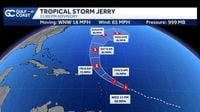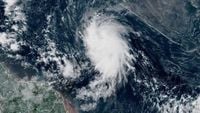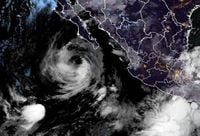Tropical weather systems are making headlines this week as two storms—Tropical Storm Jerry in the Atlantic and a weakened Priscilla in the Pacific—draw concern from meteorologists and residents across North America and the Caribbean. The 2025 Atlantic hurricane season, which stretches from June 1 through November 30, is reaching its peak, and forecasters are urging vigilance as these storms approach populated regions, bringing with them threats of heavy rain, flash flooding, and dangerous surf.
According to the U.S. National Hurricane Center (NHC), Priscilla, which flirted with major hurricane status on Tuesday, October 7, 2025, lost its hurricane designation by Wednesday. The storm's maximum sustained winds dropped to about 65 mph (100 kph) as it churned northwest at 8 mph (13 kph), positioned roughly 220 miles (355 kilometers) west of the southern tip of Baja California. Still, the storm packed enough punch to warrant a tropical storm watch for Baja California Sur, especially from Cabo San Lucas to Cabo San Lazaro. High surf and gusty winds battered the region, and forecasters warned that the risk of heavy rainfall and flash flooding would persist as Priscilla continued northward along Mexico's Pacific coast, with some of its moisture expected to reach the Southwestern United States over the weekend.
The Houston Chronicle reported that Priscilla’s remnants could bring deep tropical moisture into Arizona, New Mexico, and far West Texas late this week and into the weekend. “As much as 4 inches of rain could fall, especially in northern Arizona and southern Utah,” the outlet noted, highlighting the risk of flash flooding in areas unaccustomed to such downpours. Even as Priscilla was expected to dissipate after landfall in northern Baja California, its lingering moisture posed a significant flood threat for the typically arid American Southwest.
Meanwhile, in the Atlantic, all eyes are on Tropical Storm Jerry. As of late Wednesday, October 8, 2025, Jerry was located about 560 miles (900 kilometers) east-southeast of the northern Leeward Islands, moving west-northwest at 21 mph (33 kph) with maximum sustained winds of 65 mph (105 kph), according to the NHC. The storm is forecast to strengthen gradually and could become a hurricane by the weekend, with its core expected to near the northern Leeward Islands late Thursday and Friday.
The Gulf Coast Storm Team and USA Today both echoed these warnings, emphasizing that Jerry was likely to brush past the northern Leeward Islands, bringing tropical storm-force winds and heavy rainfall. A tropical storm watch was issued for Antigua, Barbuda, Anguilla, St. Kitts, Nevis, Montserrat, St. Barts, St. Martin, Saba, St. Eustatius, Guadeloupe, and adjacent islands. Rainfall totals of 2 to 4 inches (5 to 10 centimeters) are forecast for the region from Thursday into early Friday, with the possibility of flash flooding, especially in areas of higher terrain. Swells generated by Jerry are expected to reach the Leeward and Windward Islands on Thursday, then spread westward toward the Greater Antilles on Friday, creating life-threatening surf and rip current conditions.
AccuWeather Lead Hurricane Expert Alex DaSilva told USA Today, “We expect this storm to pass north of the Leeward Islands, bringing some wind and rain starting late Thursday and continuing into Friday.” The storm is then expected to turn north, steering away from Florida and the rest of the U.S. mainland, but indirect hazards such as rough surf and dangerous rip currents could still affect Bermuda and the U.S. East Coast.
As for the Gulf of Mexico, the National Hurricane Center and Gulf Coast News are monitoring a trough of low pressure in the southwestern Gulf, which, as of Wednesday evening, had only a 10% chance of developing into a tropical depression over the next two to seven days. Nonetheless, this disturbance is expected to bring heavy rain and gusty winds to southern Mexico later in the week. Importantly, meteorologists have made it clear that this system poses no threat to Florida or the broader Gulf Coast at this time.
In the eastern Pacific, another system—Tropical Storm Octave—was weakening about 595 miles (960 kilometers) southwest of the southern tip of Baja California, with maximum sustained winds of 45 mph (75 kph). Octave was moving east-northeast at 12 mph (19 kph) and was expected to dissipate by Thursday, posing no threat to land, according to the NHC.
These developments are part of a broader uptick in tropical activity as the Atlantic hurricane season enters its most active period. The National Hurricane Center is also monitoring three tropical waves in the Atlantic basin, including two in the Caribbean. The peak of hurricane season typically falls around September 10, with the highest concentration of storms occurring from mid-August to mid-October. In 2025, the season has already seen several named storms, including Andrea, Barry, Chantal, Dexter, Erin, Fernand, Gabrielle, Humberto, and Imelda, before Jerry.
As hurricane names are assigned each year, Jerry marks another in a long line of storms that have threatened the Caribbean and the Americas. The NHC reminds the public that “tropical cyclone” is the generic term for any rotating, organized system of clouds and thunderstorms that originates over tropical or subtropical waters and has closed, low-level circulation. Once maximum sustained winds reach 74 mph, the system is called a hurricane in the Atlantic and eastern Pacific, a typhoon in the Northwest Pacific, or a cyclone in the South Pacific and Indian Ocean.
Looking ahead, the National Weather Service’s Climate Prediction Center suggests that the southern Gulf and western Caribbean could see increased storm activity through the end of October, as the Central American Gyre—a large, slowly rotating area of low pressure—becomes more active. This pattern often spawns tropical systems in both the Atlantic and eastern Pacific, and forecasters are keeping a close eye on any signs of development.
For now, residents and travelers in affected areas are advised to stay informed and prepared. The NHC and local meteorological agencies continue to provide frequent updates, and many news outlets encourage readers to sign up for weather alerts, download tracking apps, and follow official guidance. While Priscilla and Jerry are not expected to make direct landfall in the United States, their impacts—ranging from flooding rains in Mexico and the American Southwest to dangerous surf in the Caribbean—underscore the unpredictable nature of hurricane season.
As the 2025 hurricane season marches on, the vigilance of forecasters and the preparedness of communities remain the best defense against nature’s fury.


